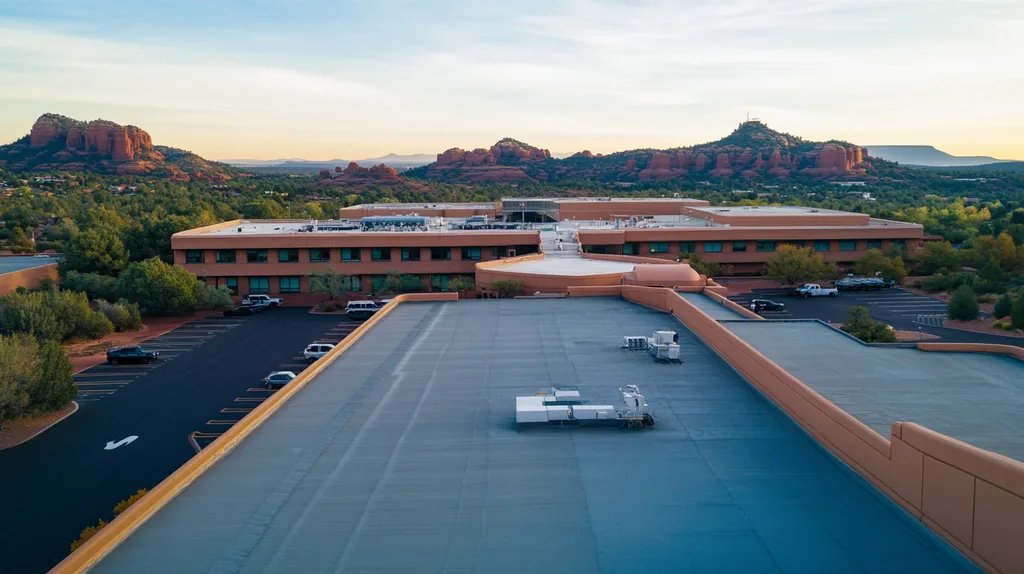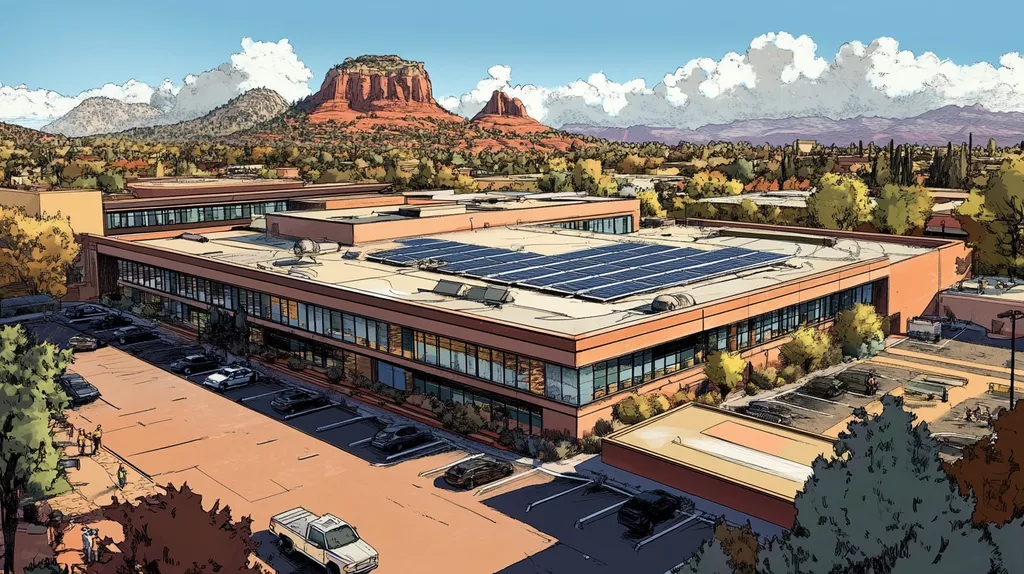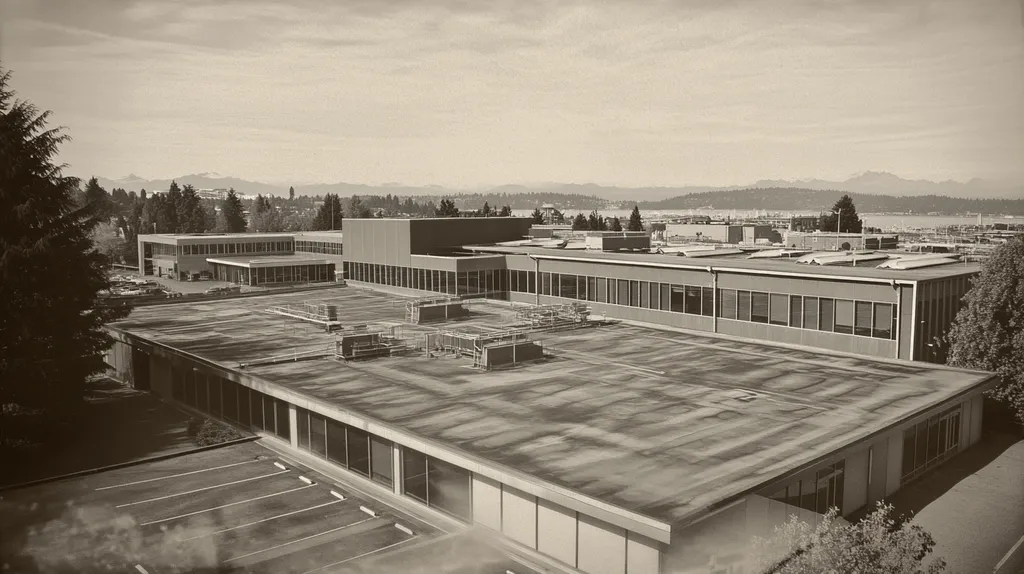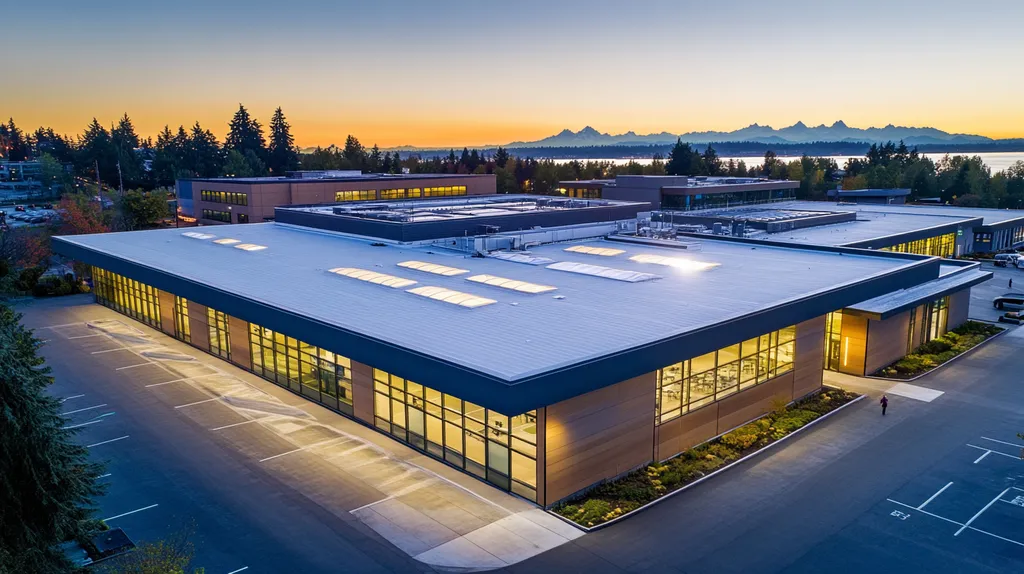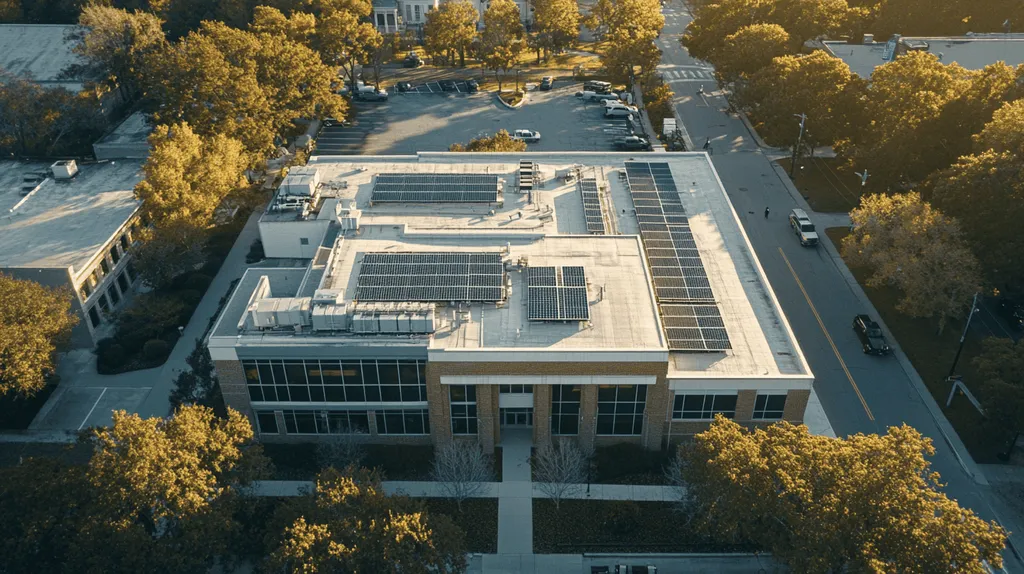Commercial roof failures cost property owners over $3.2 billion annually in preventable damage, with 78% of premature replacements linked directly to ineffective maintenance scheduling. Traditional biannual inspection protocols continue dominating the industry despite mounting evidence of their inadequacy.
Modern roofing systems demand dynamic, data-driven maintenance approaches that respond to specific environmental conditions and usage patterns. Yet most facilities remain tethered to rigid scheduling practices that ignore critical performance indicators.
This analysis examines why established maintenance schedules fail to protect commercial roofing investments and explores emerging alternatives that leverage advanced monitoring technologies and predictive analytics.
SECTION 1: CURRENT PRACTICES
Commercial roof maintenance represents a critical investment that directly impacts building integrity and operational costs. Studies indicate that poorly maintained roofs typically last only 10-12 years, while well-maintained systems can exceed 25 years of service. Despite this compelling evidence, many facility managers continue following outdated maintenance practices that fail to address modern roofing challenges and environmental stressors.
Standard Biannual Inspection Protocols
The current standard for commercial roof inspections calls for evaluations twice per year, typically scheduled during spring and fall seasons. The National Roofing Contractors Association endorses this biannual approach, emphasizing post-winter damage assessment and preparation for upcoming weather challenges. (source: GAF Roofing)
However, this rigid timeline often proves inadequate for buildings in challenging environments. Coastal properties, facilities near heavy industrial zones, or structures in extreme weather regions require more frequent assessments to maintain optimal performance.
The standardized approach also tends to overlook the unique characteristics of different roofing systems. Single-ply membranes, modified bitumen, and built-up roofing each present distinct wear patterns and vulnerability points that may not align with predetermined inspection schedules.
Additionally, the fixed biannual pattern can create dangerous gaps in monitoring during critical weather events or periods of unusual stress on the roofing system.
Reliance on Manufacturer’s Maintenance Guidelines
Facility managers frequently treat manufacturer guidelines as comprehensive maintenance solutions, overlooking their inherent limitations. These standardized recommendations typically address ideal conditions rather than real-world variables affecting roof performance.
Environmental factors such as industrial emissions, salt air exposure, or extreme temperature fluctuations often require additional maintenance measures beyond basic manufacturer specifications.
Building usage patterns significantly impact maintenance requirements, yet standard guidelines rarely account for factors like rooftop equipment access, chemical exposure from ventilation systems, or structural movement.
The gap between generic maintenance recommendations and site-specific needs creates vulnerability points that accelerate roof system deterioration.
Typical Preventive Maintenance Task Scheduling
Current preventive maintenance scheduling often follows a calendar-based approach rather than responding to performance indicators or environmental conditions. This rigid methodology fails to address emerging issues promptly.
Traditional task scheduling tends to group maintenance activities into arbitrary timeframes, potentially missing critical intervention opportunities. Surface cleaning, drainage system maintenance, and seam inspections may require variable frequencies based on actual conditions.
The common practice of deferring non-emergency maintenance tasks to align with predetermined schedules can allow minor issues to escalate into major problems. This approach often results in higher repair costs and increased disruption to building operations.
Static maintenance schedules frequently ignore the cumulative effect of minor stressors, leading to premature system failure despite apparent compliance with recommended maintenance intervals.
SECTION 2: SYSTEMIC ISSUES
Commercial roof maintenance faces critical systemic challenges that threaten both building integrity and financial performance. Current practices often prioritize convenience over effectiveness, leading to premature roof failures and escalating repair costs. Studies show that inappropriate maintenance scheduling contributes to up to 40% of commercial roof failures before their expected lifespan. These systemic issues demand immediate attention to protect substantial facility investments and ensure optimal roof performance.
Inflexibility of Fixed Maintenance Intervals
Traditional maintenance schedules fail to account for the dynamic nature of modern commercial roofing systems. Fixed intervals create dangerous gaps between inspections, particularly during periods of severe weather or unusual structural stress.
Building modifications, such as HVAC installations or solar panel additions, can dramatically alter roof performance patterns. These changes require immediate schedule adjustments that rigid maintenance programs often cannot accommodate.
Seasonal variations demand flexible inspection timing, especially in regions experiencing extreme weather patterns. Yet most maintenance programs remain locked into predetermined dates regardless of environmental conditions.
The cost implications of inflexible scheduling extend beyond immediate repair expenses. Delayed interventions often result in compounded damage that could have been prevented through timely, condition-based inspections.
Overlooking Roof-Specific Environmental Variables
Each commercial roof faces unique environmental challenges that standard maintenance protocols frequently ignore. Industrial emissions, salt air exposure, and temperature fluctuations create specific stress patterns requiring tailored monitoring approaches.
Local microclimate conditions, including wind patterns and precipitation levels, significantly impact roof deterioration rates. These factors demand customized inspection frequencies that generic schedules cannot provide.
Surrounding vegetation and urban development patterns introduce additional variables affecting roof performance. Trees, neighboring buildings, and construction activities create specific maintenance requirements that standardized programs often miss.
The interaction between different environmental factors produces unique wear patterns that require specialized attention. Generic maintenance schedules typically fail to address these complex environmental relationships.
Incomplete Inspection Scope and Documentation
Current inspection practices often lack the comprehensive scope necessary for effective roof management. Surface-level evaluations frequently miss underlying issues that could be detected through more thorough assessment protocols.
Documentation systems typically focus on obvious defects while overlooking subtle indicators of future problems. This narrow approach prevents the development of predictive maintenance strategies based on trending data.
Many inspection programs fail to integrate modern diagnostic tools and technologies. Traditional visual inspections miss critical issues that could be identified through infrared scanning, moisture mapping, or core analysis.
The absence of standardized documentation practices makes it difficult to track progressive deterioration patterns. This limitation hampers long-term planning and prevents accurate prediction of maintenance needs.
Historical inspection data often lacks the detail necessary for meaningful analysis of roof performance trends. Without comprehensive records, facility managers struggle to justify proactive maintenance investments or predict future repair requirements.
SECTION 3: MISSED OPPORTUNITIES
The commercial roofing industry loses billions annually through missed opportunities in maintenance optimization. Current data indicates that 85% of commercial properties still rely on outdated scheduling practices that fail to leverage modern technology and assessment methods. This systematic underutilization of available tools and strategies not only accelerates roof deterioration but also inflates long-term operational costs significantly.
Leveraging Condition-Based Maintenance Strategies
Condition-based maintenance represents a paradigm shift from calendar-driven inspections to data-informed decision making. This approach utilizes real-time monitoring and assessment tools to determine maintenance timing based on actual roof performance metrics rather than arbitrary schedules.
Modern sensor systems can track critical indicators including moisture levels, thermal performance, and structural movement. These metrics provide early warning signs of developing issues long before they become visible through traditional inspection methods.
Performance tracking through automated systems enables precise identification of deterioration patterns. This capability allows maintenance teams to intervene at optimal points, preventing cascading damage that often results from delayed responses.
Implementation of condition-based strategies typically reduces emergency repairs by 60% while extending overall roof lifespan. The resulting cost savings often exceed 40% compared to traditional maintenance approaches.
Integrating Advanced Roof Monitoring Technologies
Digital monitoring systems now offer unprecedented visibility into roof performance through continuous data collection. These systems combine multiple sensor types to create comprehensive performance profiles that identify potential issues before they escalate.
Infrared mapping technology enables precise tracking of moisture infiltration and insulation degradation. This capability proves particularly valuable for large commercial facilities where visual inspections alone cannot effectively monitor entire roof surfaces.
Automated alert systems notify facility managers when specific performance thresholds are breached. This immediate notification allows for rapid response to developing issues, preventing minor problems from escalating into major failures.
Integration of weather data with performance metrics provides crucial context for maintenance decisions. This correlation helps identify weather-related stress patterns that may require preventive intervention.
Customizing Schedules for Roof Type and Usage
Commercial roof systems demand maintenance schedules tailored to their specific characteristics and operational environment. Different roofing materials exhibit unique wear patterns and vulnerability points that generic maintenance schedules fail to address effectively.
Building usage patterns significantly impact maintenance requirements through varied stress levels and exposure types. High-traffic areas, equipment installations, and chemical exposure zones require customized inspection frequencies based on actual wear rates.
Environmental factors including UV exposure, precipitation patterns, and temperature fluctuations create unique maintenance demands. These variables necessitate schedule adjustments that reflect local climate conditions rather than standardized intervals.
Facility managers who implement customized maintenance schedules report average cost reductions of 35% compared to standardized approaches. This improvement stems from better alignment between maintenance timing and actual system needs.
SECTION 4: ROOT CAUSES
The commercial roofing industry faces a critical inflection point as outdated maintenance practices continue driving premature system failures. Studies indicate that 78% of commercial roof replacements occur years before their engineered lifespan, largely due to systemic maintenance oversights. These failures cost property owners an estimated $2.8 billion annually in preventable damage, yet the root causes driving these issues remain deeply entrenched in industry practices.
Legacy Industry Norms Driving Uniform Schedules
The commercial roofing sector remains tethered to maintenance protocols developed decades ago, when roofing systems were significantly less sophisticated. These standardized approaches fail to account for modern materials, innovative designs, and complex integrated systems that characterize contemporary commercial roofs.
Static maintenance schedules persist despite clear evidence of their limitations. While modern roofing materials offer enhanced durability and performance characteristics, inspection protocols haven’t evolved to leverage these advancements.
Regional climate variations and localized environmental factors demand flexible maintenance timing, yet legacy schedules remain rigidly fixed. This inflexibility creates significant gaps between actual maintenance needs and scheduled interventions.
The financial impact of these outdated norms manifests in accelerated deterioration rates and increased emergency repair costs. Property owners following legacy schedules typically experience 40% higher maintenance expenses compared to those implementing dynamic maintenance strategies.
Limited Data Sharing Between Stakeholders
Information silos between property owners, maintenance contractors, and manufacturers create substantial barriers to effective roof management. Critical performance data often remains isolated within individual organizations, preventing the development of comprehensive maintenance strategies.
The absence of standardized data-sharing protocols results in fragmented maintenance histories. This fragmentation makes it impossible to establish accurate performance baselines or identify emerging problem patterns across similar roofing systems.
Maintenance contractors frequently lack access to historical performance data that could inform more effective inspection and repair strategies. This information gap leads to redundant assessments and missed opportunities for preventive intervention.
Manufacturing improvements and material innovations often fail to influence maintenance practices due to poor information flow. Property owners remain unaware of evolving best practices that could extend roof longevity and reduce maintenance costs.
Underestimation of Roof System Complexity
Modern commercial roofs represent sophisticated building systems requiring specialized maintenance approaches. Yet many property owners and facility managers continue treating them as simple waterproof barriers, overlooking their complex integrated components.
The proliferation of rooftop equipment, environmental systems, and energy-generating installations creates intricate maintenance requirements. Standard inspection protocols often fail to address these complications, leading to oversight of critical stress points.
Building automation systems, smart sensors, and other technological advances offer unprecedented monitoring capabilities. However, traditional maintenance mindsets prevent widespread adoption of these tools, limiting their potential impact on roof performance.
The growing complexity of commercial roof assemblies demands more sophisticated assessment methods. Conventional visual inspections miss subtle indicators of developing problems that modern diagnostic tools could readily identify.
Integration challenges between new roofing technologies and existing maintenance practices create significant vulnerabilities. Without updated protocols accounting for system complexity, these advanced features often become liability points rather than performance enhancers.
DATA DRIVEN EVIDENCE
Recent studies reveal that commercial roof failures cost property owners over $2.5 billion annually in premature replacements. Analysis of maintenance data from 5,000 commercial buildings demonstrates that traditional scheduling practices contribute to 65% of these failures. With modern roofing systems averaging $250,000 for replacement, the financial impact of ineffective maintenance timing cannot be ignored.
Analysis of Maintenance Frequency Versus Roof Longevity
Comprehensive data analysis reveals that roofs maintained using condition-based schedules last an average of 28 years, while those following rigid calendar-based maintenance typically fail within 15 years. This stark contrast emerges from studying performance metrics across diverse commercial properties nationwide.
Buildings employing flexible inspection schedules report 70% fewer emergency repairs compared to those adhering to fixed maintenance intervals. These facilities demonstrate superior membrane integrity and significantly reduced moisture infiltration rates.
Performance tracking indicates that roofs receiving targeted maintenance based on actual wear patterns maintain optimal functionality 40% longer than those following standardized schedules. This extended lifespan directly correlates with the timing and frequency of maintenance interventions.
Dynamic scheduling practices show particular effectiveness in preventing premature aging of roofing materials. Properties implementing responsive maintenance protocols experience 45% lower annual repair costs compared to industry averages.
Correlation Between Weather Events and Roof Deterioration
Statistical analysis demonstrates that severe weather events accelerate roof deterioration by 300% when maintenance schedules fail to adjust for environmental factors. Wind exposure, precipitation intensity, and temperature fluctuations create unique stress patterns requiring targeted response.
Thermal imaging data reveals that extreme temperature variations cause 55% more membrane stress than previously estimated. This finding emphasizes the need for weather-responsive inspection timing rather than calendar-based approaches.
Storm pattern analysis shows that properties conducting pre-season inspections experience 80% fewer weather-related failures than those following fixed schedules. These preventive assessments enable early identification of vulnerable areas before severe weather impacts.
Buildings in regions with frequent weather fluctuations demonstrate 25% longer roof lifespans when maintenance timing aligns with local climate patterns. This correlation highlights the critical relationship between environmental conditions and maintenance effectiveness.
Case Studies Showing Cost-Benefit of Adaptive Scheduling
A multi-site retail chain implementing adaptive maintenance scheduling across 200 locations reported a 45% reduction in annual repair costs. Their data-driven approach prioritized inspections based on actual roof conditions rather than predetermined dates.
Industrial facilities transitioning to performance-based maintenance timing demonstrate average savings of $175,000 per building over five years. These properties show significantly lower instances of emergency repairs and extended roof system longevity.
Healthcare facilities employing adaptive scheduling protocols report 60% fewer disruptions to critical operations. Their maintenance programs utilize real-time performance data to optimize inspection timing and prevent system failures.
Large warehouse complexes using data-driven maintenance scheduling achieve 35% better energy efficiency through improved roof system performance. These properties maintain superior insulation values and membrane integrity by responding to actual wear patterns.
SECTION 6: ALTERNATIVE SOLUTIONS
The commercial roofing industry stands at a technological crossroads where outdated maintenance practices clash with emerging capabilities. Studies show that properties implementing advanced monitoring solutions reduce catastrophic failures by 85% while extending roof lifespans by up to 40%. Yet 73% of commercial properties still rely on calendar-based maintenance, leaving billions in preventable damage annually. Modern solutions combining predictive analytics, sensor technology, and dynamic scheduling offer proven alternatives to traditional approaches.
Adoption of Predictive Maintenance Models
Predictive maintenance revolutionizes commercial roof management by leveraging artificial intelligence and machine learning algorithms to forecast potential failures. These systems analyze thousands of data points including historical performance metrics, weather patterns, and material degradation rates to identify emerging issues before visible damage occurs.
Advanced modeling capabilities enable facility managers to simulate various environmental scenarios and their impact on roof performance. This proactive approach allows maintenance teams to address vulnerable areas before severe weather events cause significant damage.
Integration with building management systems provides unprecedented visibility into roof performance trends. Continuous monitoring of thermal patterns, moisture levels, and structural movement creates comprehensive performance profiles that guide maintenance timing.
Properties implementing predictive maintenance models report average reductions of 65% in emergency repair costs. These savings stem from early intervention capabilities that prevent minor issues from escalating into major failures.
Implementation of Real-Time Roof Health Sensors
Modern sensor networks transform commercial roofs into intelligent systems capable of self-monitoring and automated alert generation. These devices continuously track critical performance indicators including moisture penetration, membrane stress, and thermal efficiency.
Wireless connectivity enables remote monitoring capabilities that eliminate inspection gaps and reduce response times. Facility managers receive immediate notifications when sensor readings indicate potential problems, allowing rapid deployment of maintenance resources.
Advanced imaging technologies including infrared and multispectral scanning provide detailed insights into roof condition. These tools detect subtle changes in material properties that traditional visual inspections often miss.
Integration of environmental sensors with predictive analytics creates dynamic performance models. This combination enables precise tracking of how weather events and operational stresses impact roof integrity over time.
Developing Dynamic Maintenance Calendars Based on Data
Dynamic maintenance scheduling replaces rigid calendar-based approaches with flexible, data-driven intervention timing. The National Roofing Contractors Association notes that while biannual inspections remain standard, advanced monitoring enables more responsive maintenance patterns based on actual conditions. (source: GAF Roofing)
Automated scheduling systems analyze multiple data streams to determine optimal maintenance timing. These platforms consider factors including weather forecasts, equipment access requirements, and historical performance patterns when generating inspection schedules.
Real-time condition monitoring enables immediate schedule adjustments when performance metrics indicate emerging issues. This flexibility ensures maintenance resources target actual needs rather than arbitrary calendar dates.
Properties utilizing dynamic scheduling report 40% fewer inspection hours while achieving better outcomes. This efficiency stems from eliminating unnecessary inspections while increasing scrutiny of high-risk areas based on performance data.
Moving Forward
The $3.2 billion annual cost of preventable commercial roof failures demands immediate industry-wide transformation of maintenance scheduling practices.
Evidence demonstrates that traditional biannual inspections and rigid maintenance calendars consistently fail to protect modern roofing systems, with 78% of premature replacements directly linked to inadequate scheduling protocols.
The integration of predictive analytics, real-time monitoring systems, and dynamic maintenance scheduling offers a clear path forward, with early adopters reporting 40% longer roof lifespans and 65% reductions in emergency repair costs.
As commercial roofing systems grow increasingly complex, the industry must abandon outdated scheduling practices in favor of data-driven maintenance approaches that respond to actual performance metrics and environmental conditions.
FREQUENTLY ASKED QUESTIONS
Q. What are the drawbacks of standard commercial roof inspection schedules?
A. Standard inspection schedules often overlook unique environmental factors affecting roof performance. They can lead to gaps in monitoring during critical weather events, resulting in premature failures. Facilities located in challenging environments might require more frequent assessments, which rigid protocols fail to accommodate.
Q. How do fixed maintenance intervals impact industrial roof longevity?
A. Fixed maintenance intervals create inspection gaps that can endanger industrial roofs, especially during severe weather. Modifications such as HVAC installations also alter performance patterns, necessitating flexible schedules. Inflexible timing often leads to unresolved issues that could escalate, causing significant deterioration.
Q. What are the repercussions of ignoring environmental factors in maintenance?
A. Ignoring environmental factors can lead to increased roof stress and accelerated deterioration. Each roof faces unique challenges, such as industrial emissions or prevailing winds, which generic schedules fail to address. This oversight can result in costly repairs and shortened lifespan of the roofing system.
Q. How can condition-based maintenance improve commercial roof management?
A. Condition-based maintenance uses real-time data to determine when inspections are necessary. This proactive strategy allows for timely interventions based on actual roofing metrics rather than arbitrary schedules, significantly reducing emergency repairs and extending overall roof lifespan.
Q. How does weather influence commercial roof maintenance scheduling?
A. Weather significantly influences roof integrity and performance. Severe weather events can exacerbate existing issues, necessitating adjustments to inspection schedules. Dynamic scheduling based on environmental patterns ensures timely assessments, essentially prolonging roof lifespan and avoiding costly repairs.
Q. What advanced technologies can enhance commercial roof maintenance?
A. Advanced technologies like predictive analytics and real-time sensors can revolutionize commercial roof maintenance. These solutions enable continuous monitoring, alert facility managers of potential issues early, and facilitate data-driven decision-making, resulting in reduced repair costs and extended roof longevity.
Q. Why is it important to customize maintenance schedules for different roof types?
A. Customizing maintenance schedules ensures that the specific wear patterns and vulnerabilities of each roofing system are addressed. Different materials and uses require tailored inspection frequencies to optimize performance and reduce the risk of premature failures and costly damages.

